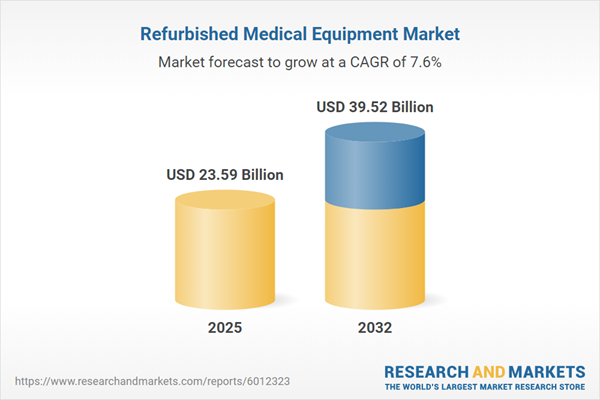Speak directly to the analyst to clarify any post sales queries you may have.
The refurbished medical equipment market is rapidly transforming how healthcare providers manage costs, sustainability goals, and clinical needs, emerging as a strategic segment within global health systems. This executive summary distills current dynamics and actionable insights for senior decision-makers evaluating their approach to capital equipment acquisition and lifecycle management.
Market Snapshot: Refurbished Medical Equipment Market Trends
The refurbished medical equipment market grew from USD 22.06 billion in 2024 to USD 23.59 billion in 2025. With projections indicating continued robust expansion at a CAGR of 7.55%, the market is on track to reach USD 39.52 billion by 2032. Demand is being propelled by mounting cost containment pressures, shifting regulatory stances favoring sustainable procurement, and advances that bolster the clinical equivalency of refurbished and new equipment. Hospitals, clinics, and research centers increasingly view this segment as a viable route to innovative care delivery and resource optimization.
Scope & Segmentation: In-Depth Breakdown of the Refurbished Medical Equipment Market
Refurbished medical equipment plays a pivotal role across multiple care modalities, supported by a broad range of product categories, device conditions, and sales channels. This research covers a comprehensive set of segments:
- Product Type: Cardiology equipment; dental units and X-rays; imaging systems such as CT, MRI, and ultrasound; surgical and anesthesia devices; patient monitoring technology.
- Condition of Equipment: Instruments fully restored to original specifications; devices with targeted minor refurbishments.
- Distribution Channel: Established offline sales networks utilized by healthcare institutions; rapidly expanding online platforms delivering direct-to-buyer transactions.
- Applications: Use cases span cardiology, gastroenterology, neurology, oncology, orthopedics, and urology.
- End-Users: Ambulatory surgery centers, diagnostic facilities, hospitals, research and academic organizations, and specialty clinics.
- Regional Markets: Americas—including North and Latin America—Europe, Middle East, and Africa, as well as Asia-Pacific markets are all distinctly evaluated.
- Company Coverage: Analysis of key market participants, including original equipment manufacturers, independent refurbishers, and technology-driven disruptors.
Key Takeaways for Senior Stakeholders
- Refurbished medical equipment has become integral to healthcare modernization and sustainability programs, aligning with both cost efficiency and environmental stewardship goals.
- Advanced diagnostic tools and digital maintenance systems have closed much of the gap in clinical performance between new and refurbished devices, leading to rising provider confidence and adoption rates.
- Ecosystem players—ranging from manufacturers to independent service providers—are leveraging service innovation, streamlined logistics, and virtual inspections to optimize value delivery and expand reach.
- Procurement strategies are increasingly focused on lifecycle management and circular economy principles, ensuring capital investments yield long-term returns and reduced waste.
- Segment diversity by application and end user enables organizations to tailor their acquisition strategies, meeting unique workflow and care delivery requirements.
- Emerging markets are adopting public-private partnerships to support refurbishment capabilities, while developed economies prioritize comprehensive support agreements and regulatory alignment for quality assurance.
Tariff Impact: U.S. 2025 Tariff Consequences
The introduction of U.S. tariffs in 2025 on certain medical technologies is reshaping sourcing strategies, pricing models, and supply chain configurations. Many providers and refurbishers are responding by expanding domestic refurbishment hubs and exploring compliant redesigns, mitigating cost escalation and ensuring a reliable supply. Ongoing regulatory engagement is expected to shape relief measures and maintain access to essential refurbished assets despite evolving trade environments.
Methodology & Data Sources
Analysis for this report is rooted in a dual approach: structured interviews and primary engagements with market stakeholders, complemented by an exhaustive review of secondary sources, including regulatory documents, clinical reports, and corporate disclosures. Key frameworks such as SWOT analysis, segmentation modeling, and scenario planning generate deep, actionable insights for decision-makers.
Why This Report Matters
- Delivers executive-level intelligence to guide procurement, operational risk mitigation, and capital planning in an increasingly cost-sensitive and regulated market.
- Empowers commercial and clinical leaders with comparative coverage of regional market trends, enabling informed expansion, partnership, and investment strategies.
- Enables robust benchmarking of competitive strategies and identifies technology and process innovations driving competitive advantage.
Conclusion
The refurbished medical equipment market presents unique opportunities for efficiency, innovation, and cost control. By leveraging these insights, organizations can confidently navigate supply dynamics and regulatory shifts while achieving sustainable growth and optimal clinical outcomes.
Additional Product Information:
- Purchase of this report includes 1 year online access with quarterly updates.
- This report can be updated on request. Please contact our Customer Experience team using the Ask a Question widget on our website.
Table of Contents
3. Executive Summary
4. Market Overview
7. Cumulative Impact of Artificial Intelligence 2025
Companies Mentioned
The companies profiled in this Refurbished Medical Equipment market report include:- Amber Diagnostics Inc.
- ArnicaHealthTech
- Avante Health Solutions
- Block Imaging International, Inc.
- Blue Star Limited
- Canon Medical Systems Corporation
- Drägerwerk AG & Co. KGaA
- FlexRay Medical ApS
- Future Health Concepts, Inc.
- GE Healthcare
- Hill-Rom Holdings, Inc. by Baxter International Inc.
- Hitachi Medical Systems
- Integrity Medical Systems, Inc.
- Koninklijke Philips N.V.
- Medtronic, Inc.
- Oxford Instruments Healthcare by MXR Imaging, Inc.
- Radiology Oncology Systems, Inc.
- Samsung Electronics
- Sanrad Medical Systems Private Limited
- Shimadzu Corporation
- Siemens Healthineers
- Soma Technology, Inc.
- Stryker Corporation
- Surplus Solutions, LLC
- TRACO Medical, Inc.
- US Med-Equip, Inc.
Table Information
| Report Attribute | Details |
|---|---|
| No. of Pages | 194 |
| Published | November 2025 |
| Forecast Period | 2025 - 2032 |
| Estimated Market Value ( USD | $ 23.59 Billion |
| Forecasted Market Value ( USD | $ 39.52 Billion |
| Compound Annual Growth Rate | 7.5% |
| Regions Covered | Global |
| No. of Companies Mentioned | 27 |









